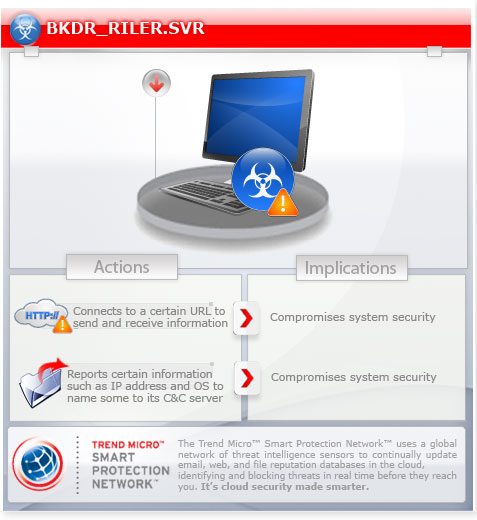BKDR_RILER.SVR
Windows 2000, Windows XP, Windows Server 2003


Threat Type: Backdoor
Destructiveness: No
Encrypted: No
In the wild: Yes
OVERVIEW
This malware arrives as an executable file infected by a file infector malware detected as PE_SALITY.AC. This consequently executes both payloads of BKDR_RILER.SVR and PE_SALITY.AC on the affected system.
To get a one-glance comprehensive view of the behavior of this Backdoor, refer to the Threat Diagram shown below.

This backdoor may be dropped by other malware.
It connects to a website to send and receive information.
TECHNICAL DETAILS
Arrival Details
This backdoor may be dropped by the following malware:
Installation
This backdoor drops the following files:
- %System%\goopnet.ini - contains the path and filename of the executed malware
- %System%\utntweep.dll - also detected as BKDR_RILER.SVR
(Note: %System% is the Windows system folder, which is usually C:\Windows\System on Windows 98 and ME, C:\WINNT\System32 on Windows NT and 2000, or C:\Windows\System32 on Windows XP and Server 2003.)
Backdoor Routine
This backdoor connects to the following websites to send and receive information:
- losang.{BLOCKED}dns.co.uk
NOTES:
As an autostart technique, it registers its DLL component as Layered Service Provider (LSP) by creating the following registry entry:
HKEY_LOCAL_MACHINE\SYSTEM\CurrentControlSet\Services\WinSock2\Parameters\Protocol_Catalog9\Catalog_Entries\0000000000{2 digit numbers}
PackedCatalogItem = "%System%\utntweep.dll"
The DLL component contains the backdoor routines of this malware. The DLL component first checks if it is injected in any of the following processes before continuing execution:
- explorer.exe
- firefox.exe
- lsvchost.exe
- msimn.exe
- msnmsgr.exe
- netscp.exe
- opera.exe
- outlook.exe
- safari.exe
- yahoomessenger.exe
Otherwise, it terminates.
It is capable of reporting the following information to its C&C server:
- Host name
- IP address
- Malware file size
- Malware version
- Operating system
It may then open a hidden instance of COMMAND.COM or CMD.EXE process in order to allow remote command shell access to the attacker.
SOLUTION
Step 1
For Windows XP and Windows Server 2003 users, before doing any scans, please make sure you disable System Restore to allow full scanning of your computer.
Step 3
Restart in Safe Mode
Step 4
Search and delete this file
- %System%\goopnet.ini
Step 5
Delete this registry value
Important: Editing the Windows Registry incorrectly can lead to irreversible system malfunction. Please do this step only if you know how or you can ask assistance from your system administrator. Else, check this Microsoft article first before modifying your computer's registry.
- In HKEY_LOCAL_MACHINE\SYSTEM\CurrentControlSet\Services\WinSock2\Parameters\Protocol_Catalog9\Catalog_Entries\0000000000{2 digit numbers}
- PackedCatalogItem = %System%\utntweep.dll
- PackedCatalogItem = %System%\utntweep.dll
Step 6
Restart in normal mode and scan your computer with your Trend Micro product for files detected as BKDR_RILER.SVR. If the detected files have already been cleaned, deleted, or quarantined by your Trend Micro product, no further step is required. You may opt to simply delete the quarantined files. Please check this Knowledge Base page for more information.
Did this description help? Tell us how we did.

